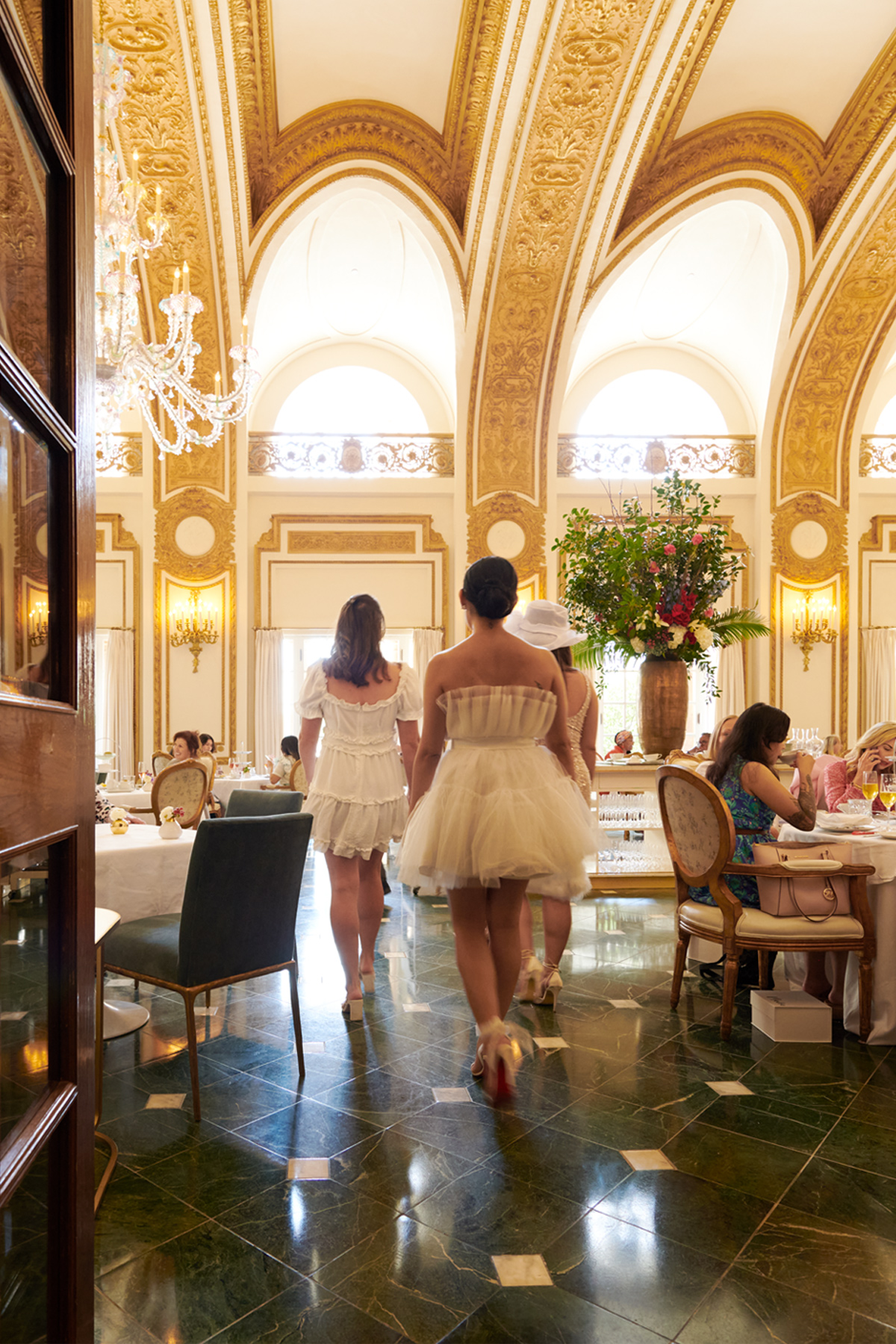One night in February, the magic was back in The French Room.
The white plaster walls of Texas’ most historic fine dining space gleamed in warm evening light. Pink rose petals were scattered across an empty table in anticipation of a young couple’s arrival. The floral centerpiece on top of the service stand branched out high over guests’ heads. An acclaimed chef from New York was in the kitchen, sending out courses of refined food.
There is no other dining room like this in our state. Sitting in The French Room, you can imagine the century of memories that has been created here: engagements, family celebrations, birthdays, anniversaries.
And yet something was not quite right.
The light streaming in the window was not all natural. A 104-foot-tall video wall installed by AT&T on the other side of Commerce Street projected bright, colorful digital artwork into The French Room’s old-fashioned space. Service was not as natural as it used to be, either, after years of pandemic-induced shutdowns had caused many employees to seek jobs elsewhere. (Since 2020, the restaurant has been open only for afternoon tea service and occasional guest chef residencies, which ended April 1.) The crowd in the dining room was different, too. For one thing, “crowd” was the wrong word. Only a few guests were scattered across a dining room that seats 73, and they were mostly playing dress-up, like the couple seemingly in costume as 1940s Havana nightclub-goers. The gentleman had even found a fedora with a red band.
We had all come to The French Room for a great meal. But we’d also come to be transported away from the everyday bustle of Dallas. That night in February, the place we were being transported to was the past. Or, at any rate, a past with a video wall.
Built with the Adolphus Hotel in 1912 and painstakingly restored in 2017, The French Room is both a historic landmark and an architectural time capsule of last century’s fine dining. Expectations are different now, especially after a global crisis that seemingly rewrote every rule of dining out. Chefs desire larger kitchens with more supplies, customers seek energy instead of elegance, and French cuisine no longer has a monopoly on luxury. The French Room must reassert its prestige while new rivals around downtown Dallas offer their own top-dollar experiences.
Paradoxically, The French Room’s potential is limited by its majesty. You can’t serve a burger in this setting. But a team of Adolphus leaders is now working to solve the room’s challenges and restore its glory for a second century. Their goal is to have all the answers—and an open restaurant—by the holiday season.
Here’s what they’re up against.
To understand the paradox of a restaurant whose greatest pride is its greatest hurdle, we must work backward through the history of fine dining in Dallas and the United States. When the Adolphus Hotel was constructed, it was an evocation of the grand hotels of Europe. French and Swiss hotels set the luxury standard the rest of the world tried to live up to. Great hotels needed great restaurants, and great restaurants usually needed to be attached to hotels.
“The reason why a lot of hotels had such a good food and beverage reputation was that traditionally only big properties, only places that had the rooms, could offset the costs of running such big brigades,” says Andrés Jiménez, senior vice president of restaurants and bars for the Adolphus’ parent company, Makeready.
The association was so strong that Delmonico’s in New York, the most famous American restaurant of the 19th century, reverse-engineered the formula by starting as a place to eat and then adding rooms. But today, many of the best dining rooms can survive independently. Dallas has an especially long history of storied hotel restaurants, from the Pyramid Room to the Mansion, but they are less relevant now than ever before. Think about your favorite restaurants. How many are in hotels?
More or less everyone at the Adolphus agrees that losing the wallpaper was a good idea. (So do I.) But the dining room is still out of step.
Restaurant architecture is changing, too. Grandiosity and scale once created the feeling of indulgence; now many diners value intimacy and privacy. As a result, high-end restaurants are moving in two directions. One option is a hushed, reverent room where chefs promote the kind of solemn foodie reverence parodied in such movies as The Menu. (New York’s Eleven Madison Park has a kitchen larger than its dining room.) The other choice is a more compartmentalized series of spaces that offers a variety of possibilities, from intimate to energetic. A multicourse dinner at The French Room doesn’t offer those choices.
“It’s just a big, grand dining room,” says Jeff Gregory, who was the restaurant’s general manager and wine director for seven months when it reopened after its 2017 remodel. “There’s not nooks and crannies. It’s not meant to be a bunch of different feels and experiences. It’s a beautiful restaurant. But if you look at Monarch or Carbone, these are also ornate restaurants, but in a different, more modern, much sexier way that appeals to the younger dining public.”
We often think today’s restaurants are especially showy or loud, but the fact that people love a spectacle when they eat is a historical constant. Gripes about restaurants being too gimmicky are as old as worries that new technology will be dangerous or that kids are getting lazy. Spectacle restaurants have been around for at least a century. At Delmonico’s, in 1879, Paul Freedman writes in his book Ten Restaurants That Changed America, the main dining room contained a “flower-banked central fountain,” while, in 1910, another location added a balcony for orchestral performances. One rival restaurant in New York was dubbed “the cathedral of froth”—by its own founder.
Flip through old copies of D Magazine, and you’ll find more relics of our longtime love of spectacle: Clouseau, a Pink Panther-themed French restaurant with pink lamé walls; La Champagne, where a harpist played during meals; and even the now-faded Old Warsaw, where a 1983 critic visited “to witness an unbelievable flaming drink production.” When clubby Deep Ellum newcomer La Neta serves a shot that’s set on fire tableside, it’s performing a trick that was already old when Instagram arrived.
And then there was The French Room, which began the 1980s with an extensive remodeling project. That renovation’s signature new addition was hand-painted wallpaper abounding with cherubs. The wallpaper stayed up until 2017, by which point some regulars incorrectly thought it was original and complained loudly when it came down.
“It was ’80s baroque,” says Sam Tucker, Makeready’s area director of sales and marketing and the Adolphus’ unofficial historian. “It was something you would see more in an English country house or a German palace. But we did receive handwritten letters about how we were destroying culture in Dallas.”
“The mural on the ceiling is probably the biggest thing I would get complaints about,” Gregory says. “People thought this was like the Sistine Chapel and someone was up there on a scaffold painting it.”
More or less everyone at the Adolphus agrees that losing the wallpaper was a good idea. (So do I.) But the dining room is still out of step with today’s more compartmentalized restaurant architecture. Dallas has very few contemporary versions of the big, grand dining room, most notably Fearing’s and Town Hearth. When I saw a drawing of Delmonico’s in 1890, with huge showpiece chandeliers, I instantly thought of Town Hearth.
Gregory says another problem with The French Room’s size is that the kitchen does not match it. When the tasting menu stretched, at times, to 13 courses, with all 73 guests potentially at different stages of that journey, the complexity of preparation became overwhelming.
“The facility was a hindrance to putting out food at the pace you need in order to keep a 13-course tasting menu under three hours,” Gregory says. “Three hours is a long time. But you look at The French Room kitchen, it’s half or a third of the size of the kitchen you would probably want to execute that kind of menu.”
That is not a unanimous opinion among those who’ve worked in it. Victoria Blamey, a Chile-born, New York-based chef, cooked up a 10-week Adolphus residency early this year. Her menu ran to a maximum of nine courses when I visited in February, including optional caviar and cheese services. Since Blamey is used to cramped kitchens in old New York buildings, she did not mind The French Room’s challenges.
“In general, it’s a really wonderful kitchen to work out of,” Blamey says. “It’s a great space. It just needs love. It needs to be running.”
The Adolphus has nine kitchens in total, and Jiménez envisions making more use of the others, especially the extensive pastry kitchen. Items could be prepped elsewhere and brought in for the final cook.
As for the room itself, the Adolphus is reviewing its options for a refresh. “We’re very cognizant about the piece in history that The French Room has played in generations, in so many families,” Jiménez says. “It’s something we certainly want to protect.”
One challenge that is high on everyone’s list: the bright, garish AT&T video board across the street. Hotel management is exploring ways of dimming the video glare that do not entail shutting the windows: applying a tint or texture, adding thin curtains that still allow light through, or even partially blocking the view with botanicals.
Otherwise, the biggest changes will be small tweaks to make the space feel more energetic. Guests may spend time in both the bar and the dining room, allowing for a variety of experiences. Blamey has another idea: “I would probably change the china. I haven’t done white plates in a long time. I do color. I do ceramics.” In a room newly restored to its classic white walls, a small pop of color might make a dramatic difference.
The room is one of just two big challenges facing the team reviving The French Room. The other is the word “French.”
It was a problem for Blamey: “When I saw the first picture when they were trying to approach me, I said, ‘Oh, my god, do you want me to do French food? Because I’m not going to do that.’ ”
The Adolphus believes that the relaunched restaurant should be at least partly French. How much, though, is open for debate.
“There’s definitely going to be a French component,” Jiménez says. “Whether it is at 60 percent or 100 percent, we’re still debating. It depends on the team we put together and what they can contribute. But we’re putting a team together within a French room with a French name.”
Truthfully, the historical relationship between French food and fine dining in the United States—like the complaint about food being showier than ever—is more complicated than most people think. French food experienced ups and downs of popularity and authenticity. Freedman chronicles that journey in his book, as does Harvey Levenstein in 1993’s Paradox of Plenty: A Social History of Eating in Modern America.
A century ago, our “French” food was not always French. Often, American game such as goose, duck, and terrapin was presented with translated names and Champagne alongside. Americans even helped invent the cliché of French snobbery. The United States, not Europe, pioneered the practice of good tables for prized regulars and bad tables for the unprivileged, including a “Siberia” of chilly service. Though one restaurateur in New York, Henri Soulé, was so snooty he almost single-handedly gave the French their bad reputation, Freedman says he was catering to local tastes: “Favoritism and snobbery were not the principal aim of Le Pavillon’s owner but rather byproducts of peculiarly American forms of social exclusivity. Americans did not need Soulé to instruct them on how to measure status by where they were seated and how they were received at restaurants.” (Le Pavillon opened in the segregated days before civil rights sit-ins.)
Until the 1960s, most Americans considered French restaurants too expensive and upper class. Travel guides were dominated, Levenstein writes, by “steak, lobster, and roast beef syndrome.” But the ’60s brought three changes: cheap flights to Europe, John F. Kennedy’s much-publicized love of French food, and the growing fame of Julia Child. The cuisine experienced an American golden age that lasted until economic crises in the 1980s sent customers flocking back to cheaper eats.
Kim Pierce, who reviewed restaurants for the Dallas Morning News for 30 years and co-edited Dallas’ first Zagat survey, in 1989, says that summary is generally true locally but cautions that “in Dallas the big deal wasn’t that they were French per se but that they were fine dining.” People wanted the best, and in the days before high-end steakhouses and sushi, the best was French. Pierce recalls French being a “slender” genre for many decades in Dallas, often lumped into a “continental” category. In D Magazine’s early years, “French/Continental” was the listing under which readers could find Chez Philippe, Calluaud’s, and Chez Gerard, next to a Swedish-themed spot called Three Vikings. Later, D used the generic term “European.”
What will replace the long tastings? That’s up for debate. Adolphus Hotel management sees no need for a celebrity chef. The room itself is the celebrity, after all.
Truly premium French food is now essentially extinct in Dallas, having ceded the field to bistros and brasseries with the closure of Bullion in early 2020. (Though Bullion promised to reopen after the pandemic, no plans have yet been announced.) The Adolphus feels pressure to bring back that lost glamor to a room that Blamey compares to the palaces of Louis XV.
The good news is that French chefs have spent the last few decades expanding the possibilities of their cuisine. The Adolphus itself tried pushing boundaries when The French Room reopened in 2018; Michael Ehlert’s striking menu modernized 1800s recipes to thrilling effect. In New York, Le Coucou and Frenchette do for French classics what Carbone does for Italian-American ones: they make the food splashy and stylish, and they serve it in memorable but informal atmospheres. Chefs such as Jean-Georges Vongerichten, Mitsunobu Nagae, and Tatiana Levha have pushed French cuisine to adopt Asian influences and ingredients, and, in Dallas, former Bullion chef Bruno Davaillon is planning a French-Asian restaurant. Chefs like Blamey use French technique to produce their own individualistic fare, influenced by their own upbringings.
In fact, Blamey suggests that the room’s inherent prestige creates an opportunity to take the food in an unexpected direction and spotlight a new voice. The Adolphus’ fame will elevate whatever food it serves.
“It’s a classic room, but you also need to see a Latina immigrant is cooking in this room,” she says. For her, the solution, if The French Room stops serving French food, is in marketing the result properly, as one tradition passing the baton to another. “It’s about the conversation. It’s about the narrative.”
The Adolphus doesn’t sound too receptive to this idea—but there is wiggle room.
“If you look at French cuisine and how it’s evolved, you could go super retro, or you could go super modern,” Jiménez says. “It’s all French. The fact that we have that French heritage is not stopping us from considering all different possibilities.”
The team is certain of three things. First, The French Room will remain a restaurant.
It sounds like an obvious statement, but it shouldn’t be taken for granted. Gregory makes a compelling pitch for converting the dining room, bar, and salon into a destination wedding venue: “You get the bride and groom coming down the stairs. It’s a great place to take photos. And then you’ve got a ready-made bar. It’s very well built for that purpose. You could get a lot of seats in that room if you were to do long banquet tables. You could decorate them as fancifully as you want to, and it’s not going to look out of place in that room.”
Gregory says that just one or two ultra luxurious weddings each weekend would keep the room profitable enough for public wine dinners and guest chef tastings on weeknights. And it would ensure that the room keeps doing what it does best: creating indelible lifelong memories—for those who can afford them. But luckily for the rest of us, the Adolphus is committed to a public restaurant.
Second, the name won’t change.
And third, the days of 13-course tasting menus are gone.
“Flexibility is king,” Jiménez says. “I’m a food and beverage lover, but I need to really be compelled to spend three or four hours in a tasting menu. I don’t think we will be well served by going that route.” Shorter tastings—maybe four or five courses—could be an option on a menu that also offers à la carte service.
Blamey and Gregory agree that a long tasting menu is not viable, but for a different reason: staffing. When the new restaurant opens, it will have to find employees and train them to the exacting standards deserved by the most beautiful dining room in Texas and embodied by longtime captain Connie Forbin, who still presides over afternoon tea.
“[Dallas] is not a market where there’s hireable people right off the street that know and understand that style of service,” Gregory says.
What will replace the long tastings? That’s up for debate. Adolphus Hotel management sees no need for a celebrity chef—the room itself is the celebrity, after all—but they do want a leader who will maintain this restaurant’s landmark status. As Tucker puts it: “This is a destination as the Adolphus, that’s a destination as The French Room, so we know the chef will be a destination, too.”
“We don’t have a 30-mile drive market here,” Tucker adds. “We have a 500-mile drive-or-fly market.” The Adolphus plans an international marketing campaign when the restaurant reopens, advertising it as a reborn culinary classic. But the hotel also wants downtown Dallas residents to feel comfortable visiting in their jeans before a show at the Majestic Theatre.
That’s a tricky balance to strike. A cozy neighborhood spot is rarely also a national destination. Pressed for examples of businesses that have perfected that balance, Jiménez suggests New York icons from varied price points: Gramercy Tavern, Le Bernardin, Balthazar, and Russ & Daughters Cafe.
Downtown Dallas’ rise as a dining neighborhood further complicates the picture. More modern destinations lurk around the corner, including Crown Block, the new fixture in Reunion Tower. Brass Ram’s menu is a throwback to a midcentury prime rib room, but its design nods to contemporary fashion with dimmer lighting, lower ceilings, and the feel of a private club. Monarch has all the trappings of a super-high-end restaurant—white tablecloths, panoramic 49th-floor views, a $290 per person tasting menu, a dress code—but it serves its finery with a light touch. (Maybe too light, with cocktails named “Buck Yeah” and “Show Me Your Kiwis.”) Monarch’s experience is also customizable—see and be seen in glamorous window seats or hide in a lounge tucked under the stairs.
A restaurant that thrives on special occasions needs a steady stream of celebrants who agree with its vision of what those occasions look like. With options like Monarch, Crown Block, and Carbone—all operated by out-of-towners—will young Dallasites find room in their hearts and wallets for a local classic that their grandparents visited?
When you see the Adolphus’ lavish dining room and alluring bar, you cheer for them to succeed. After dinner this spring, I dreamed that the Adolphus could find a chef, like Blamey, capable of combining classical finery and a new point of view. The French Room bar feels like it should be our city’s favorite place for an indulgent drink, and the dining room feels like it should be home to our city’s favorite restaurant.
I think of something Blamey told me. She said that how the new French Room carries itself, how it treats its guests, is more important than how it looks. “The room dictates so much about how stuffy this can be,” Blamey cautions. “But it doesn’t need to be that way. Just be confident.”
The Adolphus Hotel has a lot to be confident about. The French Room is not a cathedral of froth. It will inspire awe long after we’ve stopped using Instagram. Now the task ahead is to bring back excitement, to conceal the outside world and its video board, and to build a dining program that will surprise us, delight us, and take French food to a new place. The room itself will always be the star of the show. The challenge is to ensure that it is an escape, a sanctuary, a thrilling bit of time travel, a place for Dallas to keep creating unforgettable moments. Just as long as it’s not a museum of memories already made.
This story originally appeared in the July issue of D Magazine with the headline, “How Do You Solve a Problem Like The French Room?” Write to [email protected].
Author











